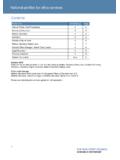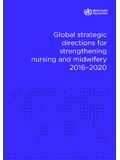Transcription of Contents
1 Health Systems Profile- Egypt Regional Health Systems Observatory- EMRO. Contents F O R E W O R D .. 5. 1 E X E C U T I V E S U M M A R Y .. 7. 2 S O C I O E C O N O M I C G E O P O L I T I C A L M A P P I N G .. 11. Socio-cultural Factors .. 11. Economy .. 11. Geography and Climate .. 12. Political/ Administrative Structure .. 12. 3 H E A L T H S T A T U S A N D D E M O G R A P H I C S .. 14. Health Status Indicators .. 14. Demography .. 15. 4 H E A L T H S Y S T E M O R G A N I Z A T I O N .. 17. Brief History of the Health Care System .. 17. Public Health Care System .. 17. Private Health Care 20. Overall Health Care System .. 21. 5 G O V E R N A N C E /O V E R S I G H T.
2 23. Process of Policy, Planning and management .. 23. Decentralization: Key characteristics of principal types .. 24. Health Information 27. Health Systems 28. Accountability Mechanisms .. 28. 6 H E A L T H C A R E F I N A N C E A N D E X P E N D I T U R E .. 29. Health Expenditure Data and Trends .. 29. Tax-based Financing .. 32. Insurance .. 33. Out-of-Pocket Payments .. 40. External Sources of Finance .. 41. Provider Payment Mechanisms .. 41. 7 H U M A N R E S O U R C E S .. 45. Human resources availability and creation .. 45. Human resources policy and reforms over last 10 55. 8 HEALTH SERVICE 59. Service Delivery Data for Health services .. 59. Package of Services for Health Care.
3 63. Primary Health Care .. 63. Non personal Services: Preventive/Promotive Care .. 75. Secondary/Tertiary Care .. 77. Long-Term Care .. 90. Pharmaceuticals .. 89. Technology ..100. 9 HEALTH SYSTEM Summary of Recent and planned reforms ..101. 10 REFERENCES ..107.. Ministry of Health and Population 1. Health Systems Profile- Egypt Regional Health Systems Observatory- EMRO. List of Tables Table Socio-cultural indicators Table Economic Indicators Table Major Imports and Exports Table Indicators of Health status Table Indicators of Health status by Gender and by urban rural 2006. Table Top 10 causes of Mortality Table Demographic indicators Table Demographic indicators by Gender and Urban rural Table Health Expenditure Table Sources of finance, by percent Table Health Expenditures by Category Table Health care financing in Egypt: coverage, eligibility and benefits Table Population coverage by source Table Distribution of HIO beneficiaries by law (1995 2002).
4 Table Comparison between 2002 and 1995 estimates Table Comparative expenditures and subsidies from MOF to hospital services, financial year 2004/2005. Table Performance Indicators Table Health care personnel Table Staff registered with syndicates Table Comparison of staff registered and in post in MOHP, December 2005. Table Staff registered and in post in MOHP plus percentage increase in difference over 20 years Table Physicians and nurses by health sector (%). Table Geographical distribution of MOHP physicians and nurses Table Distribution of physicians and nurses by governorate per 100,000. population (2005). Table Human Resource Training Institutions for Health Table Service Delivery Data and Trends Table Improvement in hospital based services (1996 2005).
5 Table Distribution of health facilities across Egypt (2006). Table Distribution of health care workers in Egypt (2006). Table Comparison of specialists (2005). Table Comparison of specialists (2005). Table Comparison of MOHP and HIO registered and in post personnel2005. Table Distribution of physicians with private clinics by number of jobs (%). 2. Health Systems Profile- Egypt Regional Health Systems Observatory- EMRO. Table Governorates distribution according to phases Table Basic preventive and promotional public health services Table Inpatient use and performance Table National distribution of inpatient beds by type of facility (2005). Table Change in hospital beds by type of provider (1991, 1997, 2001).
6 Table MOHP strategy (1997, 2001, 2017). Table Distribution of physicians among some service providers (2002). Table Bed distribution by health provider in governorates (2005). Table Beds/population by governorate and type of provider (2005). Table Private sector providers (2005). Table Private sector services (2002). Table expenditure by type of provider and ownership 3. Health Systems Profile- Egypt Regional Health Systems Observatory- EMRO. List of Figures Figure 1 Uses of health resources, by categories of providers Figure 2 Sources of revenues for the health sector, 1995. Figure 3 Distribution of HIO beneficiaries by law (1995 2002). Figure 4 Distribution of physicians and nurses by governorate per 100,000.
7 Population (2001). Figure 5 Beds per populations in governorates Figure 6 Growth trends in the pharmaceutical market Figure 7 Expected value of the market size in 2010. Figure 8 Trend in drug consumption as expenditure per capita Figure 9 Drug expenditure in private and governmental sector Figure 10 Distribution of drug consumption by therapeutic category (2001 2002). 4. Health Systems Profile- Egypt Regional Health Systems Observatory- EMRO. F OREWORD. Health systems are undergoing rapid change and the requirements for conforming to the new challenges of changing demographics, disease patterns, emerging and re emerging diseases coupled with rising costs of health care delivery have forced a comprehensive review of health systems and their functioning.
8 As the countries examine their health systems in greater depth to adjust to new demands, the number and complexities of problems identified increases. Some health systems fail to provide the essential services and some are creaking under the strain of inefficient provision of services. A number of issues including governance in health, financing of health care, human resource imbalances, access and quality of health services, along with the impacts of reforms in other areas of the economies significantly affect the ability of health systems to deliver. Decision-makers at all levels need to appraise the variation in health system performance, identify factors that influence it and articulate policies that will achieve better results in a variety of settings.
9 Meaningful, comparable information on health system performance, and on key factors that explain performance variation, can strengthen the scientific foundations of health policy at national, regional and international levels. Comparison of performance across countries and over time can provide important insights into policies that improve performance and those that do not. The WHO regional office for Eastern Mediterranean has taken an initiative to develop a Regional Health Systems Observatory, whose main purpose is to contribute to the improvement of health system performance and outcomes in the countries of the EM. region, in terms of better health, fair financing and responsiveness of health systems.
10 This will be achieved through the following closely inter-related functions: (i) Descriptive function that provides for an easily accessible database, that is constantly updated; (ii). Analytical function that draws lessons from success and failures and that can assist policy makers in the formulation of strategies; (iii) Prescriptive function that brings forward recommendations to policy makers; (iv) Monitoring function that focuses on aspects that can be improved; and (v) Capacity building function that aims to develop partnerships and share knowledge across the region. One of the principal instruments for achieving the above objective is the development of health system profile of each of the member states.
















